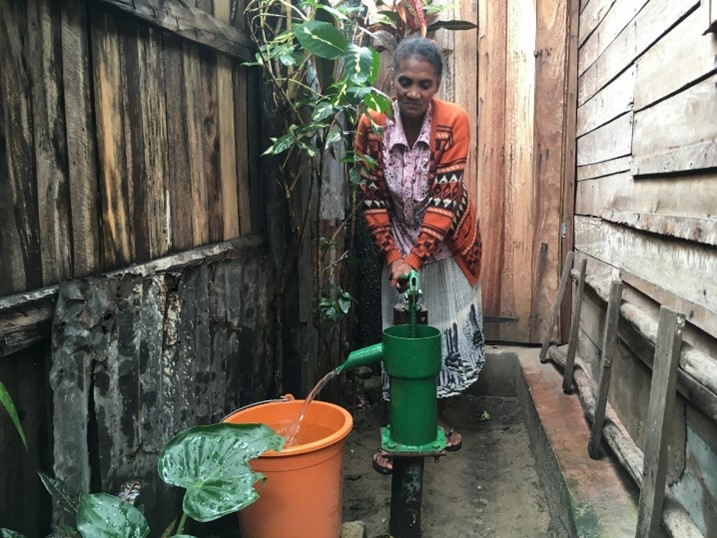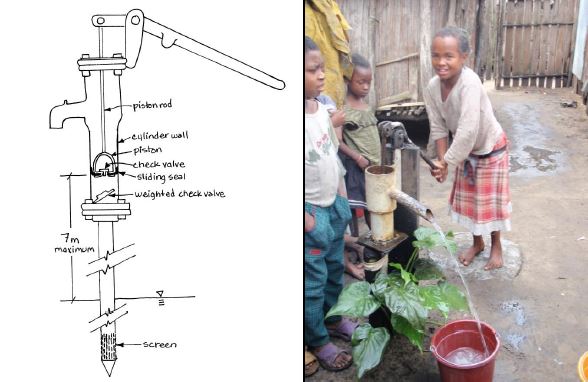Khaliq et al. (2021), International Journal of Environmental Research and Public Health

Abstract: Lead (Pb) exposure through water contamination is an important issue at the intersection of public health and water, sanitation, and hygiene (WASH). Behavior-change programs designed to address this pressing problem rarely take a behavioral-science-informed approach, nor do they consider the role of intermediate players who often influence and support behavior change. Social marketing segments the population and focuses on the consumer/user throughout program development and implementation. To illustrate the social marketing process, this cross-sectional, qualitative design study investigates the use of Pb in the construction and maintenance of household pitcher pumps for potable water in Madagascar. A sample of 18 technicians were interviewed on their current practices, motivators, barriers, and communication channels for knowledge exchange. The results reveal the importance of peers, those considered experts or “market mavens”, and the need for information on the dangers of Pb as an outdated practice for any future intervention. This study advances the notion of a design shift within engineering WASH projects, whereby social/behavioral approaches are used to consider the needs, concerns, and current behaviors of the consumer. We also advocate for engaging intermediate players who often influence behavior change in the rollout of an engineering innovation.
Buerck et al. (2021), Environmental Science & Technology

Abstract: In low- and middle-income countries (LMICs), the presence of an informal economy can lead to human exposure to toxic metals such as lead (Pb). This paper demonstrates the local health and economic benefits of modifying practices within the informal economic sector in Madagascar. Specifically, leaded components in 504 locally manufactured household water pumps were replaced with unleaded components. Prior to the intervention, 32% of the household systems exhibited lead concentrations above the World Health Organization (WHO) provisional drinking water guideline of 10 μg/L, but after the intervention, fewer than 3% of the systems were in exceedance. The reduction of lead concentration is modeled to reduce the fraction of children with elevated BLLs (>5 μg/dL) from 34 to 13%. The reduction in BLLs is estimated to provide an average economic benefit of US$11 800 per child based on predicted increases in lifetime productivity. This corresponds to a total benefit of US$8.7 million for the 730 children aged 1–5 associated with the pumps, representing a return on investment of greater than 1000-to-1. Results demonstrate how the formation of partnerships between public, private, and civil society entities, as suggested by UN Sustainable Development Goal 17, can realize important local economic and health benefits in LMICs.
Akers et al. (2019), Exposure and Health

Abstract: Thousands of households in coastal Madagascar that employ pitcher-pump systems to provide water for domestic use may be at risk for harmful exposure to lead (Pb), which leaches from locally manufactured pump system components. The Integrated Exposure Uptake Biokinetic model (IEUBK) can predict blood lead levels (BLLs) in exposed children, thereby characterizing potential health risks. However, it is unclear if the existing methodology of the IEUBK accounts adequately for dietary Pb contributions from contaminated cooking water. Therefore, aims of this study are (1) to develop a method for modifying the IEUBK to account for contaminated cooking water, (2) to quantitatively estimate the importance of dietary Pb uptake (relative to other routes of Pb exposure) in coastal Madagascar, and (3) to estimate BLLs of children in that area, accounting for dietary uptake. Results show that if the Pb concentration in household drinking and cooking water is low (≤ 4 µg/L), Pb in cooking water is not a major route of exposure; predicted BLLs in children are low regardless of whether the dietary component is modified. However, the importance of dietary intake increases with water concentration: if the household aqueous Pb concentration increases from 4 to 24 µg/L, corresponding to the 90th percentile concentration measured in a field campaign, then the estimated dietary contribution to total Pb uptake can exceed 50%. Based on median measured Pb concentrations (11 µg/L), 7–14% of children in households using pitcher-pump systems in coastal Madagascar would present with BLLs > 5 µg/dL (i.e., levels implicated in developmental health issues); however, this number could exceed 90% in households or communities where the water concentration is particularly high. An important conclusion is that the IEUBK should be modified when applied to a developing-world context, where preparation of a starch food staple like rice may present considerable Pb exposure; omitting dietary uptake in cooking water potentially ignores the dominant route of Pb exposure.
Akers et al. (2015), Environmental Science & Technology

Abstract: Thousands of households in coastal Madagascar rely on locally manufactured pitcher-pump systems to provide water for drinking, cooking, and household use. These pumps typically include components made from lead (Pb). In this study, concentrations of Pb in water were monitored at 18 household pitcher pumps in the city of Tamatave over three sampling campaigns. Concentrations of Pb frequently exceeded the World Health Organization’s provisional guideline for drinking water of 10 μg/L. Under first-draw conditions (i.e., after a pump had been inactive for 1 h), 67% of samples analyzed were in excess of 10 μg/L Pb, with a median concentration of 13 μg/L. However, flushing the pump systems before collecting water resulted in a statistically significant (p < 0.0001) decrease in Pb concentrations: 35% of samples collected after flushing exceeded 10 μg/L, with a median concentration of 9 μg/L. Based on measured Pb concentrations, a biokinetic model estimates that anywhere from 15% to 70% of children living in households with pitcher pumps may be at risk for elevated blood lead levels (>5 μg/dL). Measured Pb concentrations in water were not correlated at statistically significant levels with pump-system age, well depth, system manufacturer, or season of sample collection; only the contact time (i.e., flushed or first-draw condition) was observed to correlate significantly with Pb concentrations. In two of the 18 systems, Pb valve weights were replaced with iron, which decreased the observed Pb concentrations in the water by 57–89% in one pump and by 89–96% in the other. Both systems produced samples exclusively below 10 μg/L after substitution. Therefore, relatively straightforward operational changes on the part of the pump-system manufacturers and pump users might reduce Pb exposure, thereby helping to ensure the continued sustainability of pitcher pumps in Madagascar.
McCarthy et al. (2013), Water Alternatives

Abstract: Self-supply is widely reported across various contexts, filling gaps left by other forms of water supply provision. This study assesses mature and unsubsidised Self-supply markets in an urban context in Madagascar. Locally manufactured drilling and pumping technologies are widely provided by the local private sector, enabling households to access shallow groundwater. The market for Pitcher Pump systems (suction pumps fitted onto hand-driven boreholes) has developed over several decades, reaching a level of maturity and scale. In the eastern port city of Tamatave, 9000 of these systems are estimated to be in use and Self-supply constitutes a primary domestic water source for the majority of the city’s 280,000 inhabitants. The market is supplied by more than 50 small businesses that manufacture and install the systems at lower cost (US$35-100) than a connection to the piped water supply system. Mixed methods are used to assess the performance of the Pitcher Pump system and the characteristics of the market. Discussion includes a description of the manufacturing process and sales network that supply Pitcher Pump systems, environmental health concerns related to water quality, pump performance, and system management. In a context where urban piped water supplies are unlikely to be accessible to all anytime soon, recommendations are made for further research and potential technology developments to improve the performance of Self-supply.



